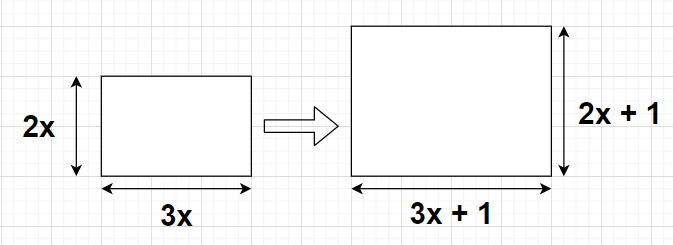
The length and breadth of a rectangle are in the ratio 3 : 2 respectively. If the sides of the rectangle are extended on each side by 1 m, the ratio of the length to the breadth becomes 10 : 7. Find the area of the original rectangle in square metres.
$
{\text{A}}{\text{. 23 }}{{\text{m}}^2} \\
{\text{B}}{\text{. 11 }}{{\text{m}}^2} \\
{\text{C}}{\text{. 54 }}{{\text{m}}^2} \\
{\text{D}}{\text{. 10 }}{{\text{m}}^2} \\
$
Answer
506.7k+ views
Hint: Here, we will proceed by obtaining one equation in one variable according to the problem statement in order to find the value of that variable. Here, we will also use the formula i.e., Area of the rectangle = (Length)(Breadth).
Complete step-by-step answer:
Given, Ratio of the original length to the original breadth of the rectangle = 3 : 2
i.e., $\dfrac{{{\text{Original Length}}}}{{{\text{Original Breadth}}}} = \dfrac{3}{2} = \dfrac{{3x}}{{2x}}$ (say)
$ \Rightarrow $Original Length of the rectangle = 3x m
$ \Rightarrow $Original Breadth of the rectangle = 2x m
Now, when all the sides of the rectangle are extended by 1 m, we have
Final Length of the rectangle = (3x+1) m
Final Breadth of the rectangle = (2x+1) m

So, $\dfrac{{{\text{Final Length}}}}{{{\text{Final Breadth}}}} = \dfrac{{3x + 1}}{{2x + 1}}{\text{ }} \to {\text{(1)}}$
It is given that the ratio of the final length to the final breadth of the rectangle after extending each side by 1 m is 10 : 7
i.e., $\dfrac{{{\text{Final Length}}}}{{{\text{Final Breadth}}}} = \dfrac{{10}}{7}$
By substituting equation (1) in the above equation, we get
$ \Rightarrow \dfrac{{3x + 1}}{{2x + 1}} = \dfrac{{10}}{7}$
By cross multiplying the above equation, we get
$
\Rightarrow 7\left( {3x + 1} \right) = 10\left( {2x + 1} \right) \\
\Rightarrow 21x + 7 = 20x + 10 \\
\Rightarrow 21x - 20x = 10 - 7 \\
\Rightarrow x = 3 \\
$
$ \Rightarrow $Original Length of the rectangle = 3x = 3(3) = 9 m
$ \Rightarrow $Original Breadth of the rectangle = 2x = 2(3) = 6 m
As we know that the area of any rectangle is given by
Area of the rectangle = (Length)(Breadth)
$ \Rightarrow $Area of the original rectangle = (Original Length of the rectangle)(Original Breadth of the rectangle)
$ \Rightarrow $Area of the original rectangle = (9)(6) = 54 ${{\text{m}}^2}$.
Hence, option C is correct.
Note: In this particular problem, the ratio given are in the most simplified form so in order to obtain the values of the numerator and denominator of that ratio we will multiply both the numerator and denominator with same number (in this case it is x) which is the same ratio as the given ratio because this number can be cancelled.
Complete step-by-step answer:
Given, Ratio of the original length to the original breadth of the rectangle = 3 : 2
i.e., $\dfrac{{{\text{Original Length}}}}{{{\text{Original Breadth}}}} = \dfrac{3}{2} = \dfrac{{3x}}{{2x}}$ (say)
$ \Rightarrow $Original Length of the rectangle = 3x m
$ \Rightarrow $Original Breadth of the rectangle = 2x m
Now, when all the sides of the rectangle are extended by 1 m, we have
Final Length of the rectangle = (3x+1) m
Final Breadth of the rectangle = (2x+1) m

So, $\dfrac{{{\text{Final Length}}}}{{{\text{Final Breadth}}}} = \dfrac{{3x + 1}}{{2x + 1}}{\text{ }} \to {\text{(1)}}$
It is given that the ratio of the final length to the final breadth of the rectangle after extending each side by 1 m is 10 : 7
i.e., $\dfrac{{{\text{Final Length}}}}{{{\text{Final Breadth}}}} = \dfrac{{10}}{7}$
By substituting equation (1) in the above equation, we get
$ \Rightarrow \dfrac{{3x + 1}}{{2x + 1}} = \dfrac{{10}}{7}$
By cross multiplying the above equation, we get
$
\Rightarrow 7\left( {3x + 1} \right) = 10\left( {2x + 1} \right) \\
\Rightarrow 21x + 7 = 20x + 10 \\
\Rightarrow 21x - 20x = 10 - 7 \\
\Rightarrow x = 3 \\
$
$ \Rightarrow $Original Length of the rectangle = 3x = 3(3) = 9 m
$ \Rightarrow $Original Breadth of the rectangle = 2x = 2(3) = 6 m
As we know that the area of any rectangle is given by
Area of the rectangle = (Length)(Breadth)
$ \Rightarrow $Area of the original rectangle = (Original Length of the rectangle)(Original Breadth of the rectangle)
$ \Rightarrow $Area of the original rectangle = (9)(6) = 54 ${{\text{m}}^2}$.
Hence, option C is correct.
Note: In this particular problem, the ratio given are in the most simplified form so in order to obtain the values of the numerator and denominator of that ratio we will multiply both the numerator and denominator with same number (in this case it is x) which is the same ratio as the given ratio because this number can be cancelled.
Recently Updated Pages
Master Class 9 General Knowledge: Engaging Questions & Answers for Success

Master Class 9 English: Engaging Questions & Answers for Success

Master Class 9 Science: Engaging Questions & Answers for Success

Master Class 9 Social Science: Engaging Questions & Answers for Success

Master Class 9 Maths: Engaging Questions & Answers for Success

Class 9 Question and Answer - Your Ultimate Solutions Guide

Trending doubts
Fill the blanks with the suitable prepositions 1 The class 9 english CBSE

How do you graph the function fx 4x class 9 maths CBSE

Name the states which share their boundary with Indias class 9 social science CBSE

Difference Between Plant Cell and Animal Cell

What is pollution? How many types of pollution? Define it

What is the color of ferrous sulphate crystals? How does this color change after heating? Name the products formed on strongly heating ferrous sulphate crystals. What type of chemical reaction occurs in this type of change.




